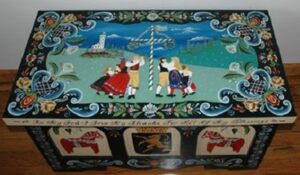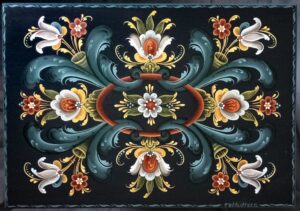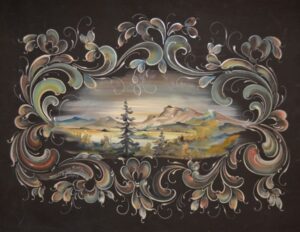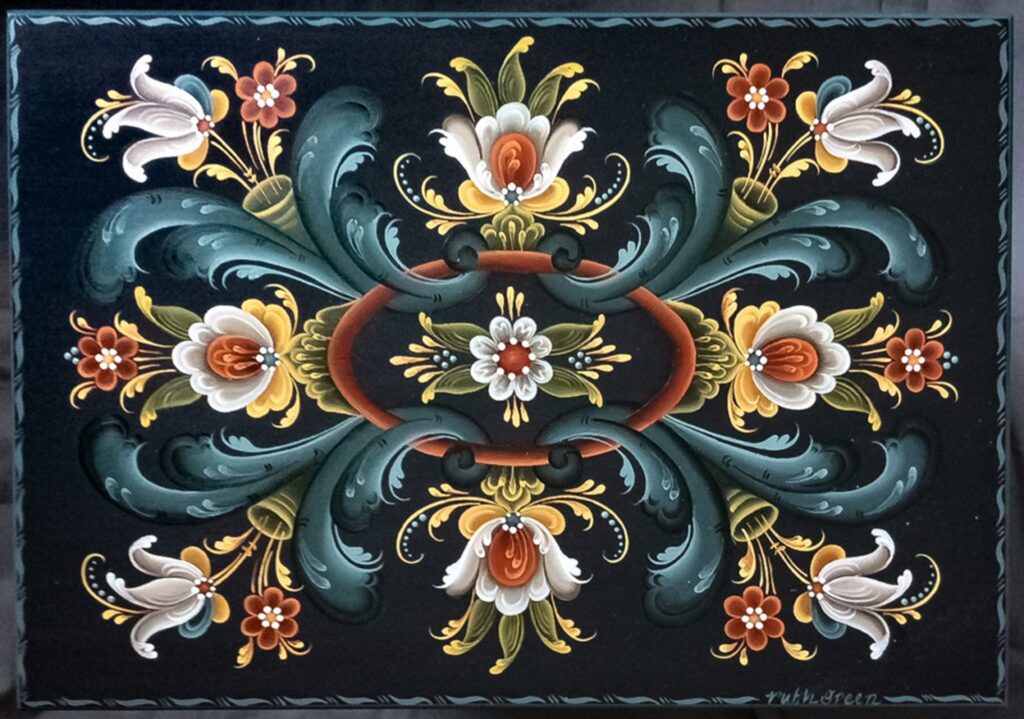The Story of Norwegian Rosemaling
Rosemaling is the decorative folk painting of Norway and its history began in the low-land areas of Eastern Norway about 1750 inspired by upper-class artistic styles when Baroque, Regency and Rococo were introduced to Norway’s rural cultures. At first Norway’s painters followed these European styles closely.

At the beginning of the century, Norway had a population of a mere 500,000 – with only 40,000 people living in what was defined as urban areas. It was a society based on the age-old ways of agriculture, fishing and hunting – and people lived on farms or in cottages scattered across the long-stretched landscape.
The story of Norwegian rosemaling
Compared to the art of woodcarving and textile art, rosemaling is a much younger art form, at least on a larger scale, and it may come as a surprise that the history of rose painting and its place in Norwegian folk art is not as old as one might think. Painter and author, Nils Elingsgard, has chronicled the journey of the art form.
The painters who rosemaled for their livelihood were trained within a “guild” and they traveled from county to county painting churches and/or the homes of the wealthy for a commission of either money or merely room and board. Thus, rosemaling was carried over the mountains and toward Norway’s western coast.
How did Rosemaling come to America?

Norwegian rosemaling continued its westward migration all the way to America. Emigration was heavy from some of the areas where rosemaling was well established. Travelers packed beautifully rosemaled trunks to make their journey across the Atlantic. Well-known as well as lesser known painters traveled to the New World.
Per Lysne, a Norwegian immigrant from Stoughton, Wisconsin rekindled an interest in Scandinavian folk art when his “Smørgaasbord” plates were sold in Chicago’s Marshall Fields department store in the late 1930’s. European folk art was rediscovered through home decorating magazine articles in the 1930’s and 1940’s.
A traditional form of art
Some of the artists in Norway often worked as farmers during the summer, subsidizing their living in the winter months painting rooms and furniture for more successful farmers.
The art displays many stylized flowers and scroll forms, combining blended colors and fine outlines on a plain background color. Traditional paint colors were derived from local raw materials, for example, rust red came from red iron oxide in the ground. Brushes were made of hairs from a squirrel’s tail or a cow’s ear.
Once farther away from the influence of the guilds, these artists tried new ideas and motifs. Soon strong regional styles developed. The Norwegian authority on the art of decorative painting – or rosemaling Nils Ellingsgard has through his gem of a book, Norsk rosemaling, given us a better understanding of this world of artistic beauty.

As time passed the Telemark and Hallingdal valleys became known for their fine rosemaling. Upon their exposure to rosemaling, rural folk would often imitate this folk art. Not having been taught in an urban guild, the amateur became spontaneous and expressive in his work on smaller objects such as drinking vessels and boxes.
The future of rosemaling
Rosemaling went out of style in about 1860-1870. Whether the traditions will continue to bloom is difficult to predict, but the many surviving objects will stay on and give joy to future generations for centuries to come. Objects that are symbols of our common history – and the many people who created them.
